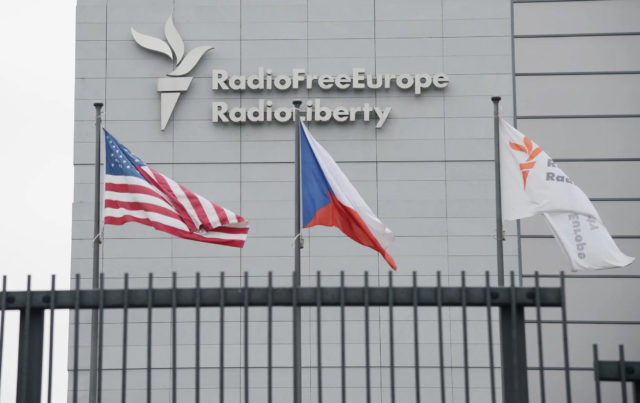We live in an age of information overload. It is not so much that accurate information is lacking, but rather that it is subsumed in a crowded, cacophonous environment. The internet, cellphones, and social media platforms have revolutionized the way information is consumed and this trend will only accelerate with future waves of technology.
While many legacy private news media companies are struggling to survive in this new environment, there is no dearth of state-funded or supported media enterprises. America’s adversaries have understood the adage, written in a letter by al-Qaeda leader Aymen al-Zawahiri to an Iraqi subordinate, that “more than half of the battle is taking place in the battlefield of the media.” Russia, China, Iran, and Islamist terrorist groups are aggressive in the media space. The states mentioned not only use social media but broadcast media as well in addition to trying to disrupt the messaging of their adversaries.
In the United States, government foreign broadcasting was – correctly – initially connected to conflict and an ideological struggle. The beginning of U.S. government broadcasting in foreign languages is intimately connected to the Second World War and the need to counter Axis propaganda in Latin America and on the warfront. Voice of America (VOA) was first, followed by Radio Free Europe (broadcasting to the captive countries of Eastern Europe) in 1949 and Radio Liberty (broadcasting to the Soviet Union) in 1953. Those two outlets would eventually merge in 1976 as Radio Free Europe/Radio Liberty (RFE/RL). VOA’s own broadcasting in Russian began in 1947, even before RFE/RL.
From the beginning, there was an effort to differentiate between two models of broadcasting. VOA was the official, state media outlet representing accurate news and the views of the U.S. government. RFE/RL (and other networks to follow) were meant to be surrogate media, representing news and views impossible to hear in countries under the Communist yoke. It is no surprise that RFE/RL was funded by the Central Intelligence Agency for decades (until 1972) through a cutout anti-Communist exile organization. The CIA supposedly exercised very light oversight over these broadcasters to the extent that the radios sometimes presented views of opposition political trends – nationalists, monarchists, rightists, liberals, whatever was banned in the motherland – as much as an American agenda. It was RFE that directly encouraged Hungarian freedom fighters during the 1956 revolt in that country. RFE/RL was such a thorn in the side of the Communists that it was subject to a terrorist attack in 1981 by Carlos the Jackal bankrolled by the Romanian Securitate and Soviet KGB.
Freedom’s Megaphone Expands
These broadcasters would be joined in 1985 by U.S. government broadcasting to Cuba, Radio and TV Marti and then by Radio Free Asia (RFA) in 1996, focusing on East Asia, particularly China. Finally Middle East Broadcasting Networks (MBN), broadcasting in Arabic, began in 2002 with Radio Sawa and then al-Hurra Televison (note: I was president of MBN from 2017 to 2020). RFA had its genesis as a response to the 1989 Tiananmen Square crackdown in China while MBN was very much a response to what was seen as a failure to communicate following the Sept. 11, 2001 terrorist attacks.
VOA and Radio/TV Marti are government agencies, while RFE/RL, RFA and MBN are technically private corporations – “grantees” – fully funded by the U.S. government. All five broadcasters are overseen by the Agency for Global Media (USAGM), formerly the Broadcasting Board of Governors (BBG), an independent government agency often derided in employee polling as the worst agency to work for in the federal government.
It is both ironic and unsurprising that the absolute nadir of American international broadcasting came with the fall of the Soviet Union. The period of 1999 to 2015 was one in which there seemed to be no one in charge at BBG. I was still in government at the time and the open derision expressed by senior State Department and White House officials for BBG operations was painful to hear.
Despite the seeming drift of those years, criticism of lack of direction and absence of solid measurements, those years did see the establishment of Farsi-language Radio Farda in 2002 as a joint VOA/RFE/RL initiative, the launching of Arabic language MBN in 2002-2004, and most importantly, the launch in 2014 of a modest Russian language television news program Current Time (Nastoyashchee Vremya) by RFE/RL in conjunction with VOA. The idea was that this would provide a “reality check” alternative to Russian regime propaganda. By 2017, Current Time had expanded to be a 24/7 operation in broadcast and digital formats.
Despite this ostensible progress on the American side, these same years saw a great expansion in Russian, Chinese and Iranian media propaganda networks. These were also the years that saw the rise of Qatari-funded al-Jazeera television to prominence after its launch in 1996 and, from 2013, the innovative use of social media by the terrorist group known as the Islamic State or ISIS.
In relative terms, American broadcasting improved with better management after media executive John Lansing was hired in 2015 as CEO (a position he held from 2015 to 2019). A small but significant launch during those years was the Russian language fact-checking site factograph.info (Polygraph.info in English), started in 2017, to counter Moscow’s disinformation. This was later expanded to counter Chinese disinformation. The Lansing era rightly saw the Russian, Chinese, and Iranian media spaces identified as priorities to be addressed immediately and in the future. The Biden administration requested $840 million in fiscal 2023 for the USAGM agencies.
Challenges from Russia, China, and Iran
Despite some successes and a correct focus on the most important issues, major challenges confront American international broadcasting. Given the nature of the threat, USAGM has still “underinvested” in confronting China. Radio Free Asia seems underfunded given China’s oversized and nefarious role in the world. There is still no 24/7 U.S. government television broadcasting to China in Mandarin and Cantonese. RFA is much smaller than RFE/RL because Russia was regarded as the bigger threat than China, but the reverse seems to be true now.
RFE/RL’s Radio Farda and VOA’s Persian Service both seek to reach the Farsi speaking population in Iran. Both services have been the subject of repeated and credible complaints by Iranian diaspora communities claiming pro-regime bias, especially at VOA. A logical change would be to combine the services and make a refurbished Radio/TV Farda a true surrogate network offering the oppressed Iranian people encouragement and inspiration – and hard, verified news – as they struggle under regime oppression.
The ambivalent position that the last two Democratic administrations have had toward the Iranian regime have made it more difficult for American broadcasting in Farsi to find its own voice and tone in its outreach to the people of Iran. U.S. broadcasting to Iran is also in the wrong agency; instead of being in Radio Free Europe, it should be part of an expanded Middle East Broadcasting Networks (MBN), creating obvious synergies and harmonizing content and regional focus.
While there has been underinvestment on China and division and confusion on Iran, the focus on Russia has been relatively clear, at least over the past five years. USAGM – working through RFE/RL and VOA – plan to “surround” Russia with enhanced media sites seems technically sound and eminently logical.
The Question of Ideology
The bigger problem facing American broadcasting to China, Russia and Iran is not so much a technical nor a financial one but an ideological one. There is, as President George H.W. Bush called it, “the vision thing.” All U.S.-funded broadcasters must adhere to ethical and professional news media standards, but beyond that the question remains: what kind of broadcasters are they to be? The “VOA model” is that of a government-funded media outlet very much along the lines of typical liberal American legacy media. It is no surprise that VOA is the “wokest” of these government media outlets and indeed was headed from 2016 to 2020 by veteran journalist Amanda Bennett, liberal media royalty. Bennett was nominated by the Biden administration in 2021 to be the next CEO of USAGM, overseeing all of U.S. international broadcasting, not just VOA.
Challenges in the Studio
A recent Heritage Foundation study by Max Primorac and James Roberts outlined how American foreign aid has all too often become an extension of one party, the Democratic Party, “seeking to advance its radical global agenda of ideological indoctrination,” weaponizing foreign aid programs to inflict the latest Washington Beltway progressive causes on an unsuspecting world. The same risk exists in international broadcasting; political and ideological diversity can be lacking, in which case the default editorial position can reflect whatever the Washington Post or New York Times deems significant. The brief, chaotic tenure of Trump appointee Michael Pack as CEO at USAGM (June 2020-January 2021) ironically only entrenched that default progressive ideology often found in federal bureaucracy.
The challenge today is even deeper, perhaps, given America’s ideological turmoil and partisan divide the past few years. How do you promote a positive, engaging and uplifting American vision of the world when significant elements of the American elite – certainly the media and cultural elite – themselves see America not just as deeply flawed but racist and rotten from its origin to this day? Such an image of the United States was, of course, propagated by Soviet propaganda and it is alive and well today in the messaging of Russia, China, and Iran. All of them, and Islamists too, have learned how to manipulate and implement the very language of American evil exceptionalism found on many American university campuses or in progressive newsrooms.
In contrast to the VOA model, we have the surrogate broadcasting model pioneered by RFE/RL in its CIA days. The risk in this model is that, left to their own devices, such broadcasters can fall into the trap of promoting their own agenda or even that of their target country regime, instead of providing a truthful news alternative to the state propaganda to which their listeners are subjected. Instead of being too official and safe, U.S. government foreign media can become too biased and reckless.
When I was at MBN that was the biggest risk and something I had to watch closely – ensuring that the Lebanese-origin journalist was not soft on Hezbollah or that the Syrian-born editor was not easy on Bashar al Assad. This is also the complaint about broadcasting to Iran, that U.S. Government outlets could be weak toward the regime. Similarly, some criticism of VOA broadcasting to China that it was occasionally relatively accommodating to Beijing’s Communist Party regime.
How to maneuver in such turbulent waters? The task is to find and cleave to a golden mean of messaging which is both deeply rooted in ethical and professional journalism but also has an engaged and expansive vision of a humane, democratic and pluralistic Russia, China, or Iran that is not just a knockoff of whatever conventional wisdom is in fashion along the Acela Corridor.
This is easier said than done. But it has the virtue of truly speaking to the aspirations of these peoples, all of them heirs to ancient empires and civilizations, in a way that is more convincing than just saying that they need to be like Americans because the West knows best. The most vital element in a rejuvenated and empowered American outreach to the world is not just a nuanced understanding of the world and our adversaries but an understanding of ourselves.
Ambassador (ret.) Alberto M. Fernandez is Vice President of the Middle East Media Research Institute (MEMRI).






